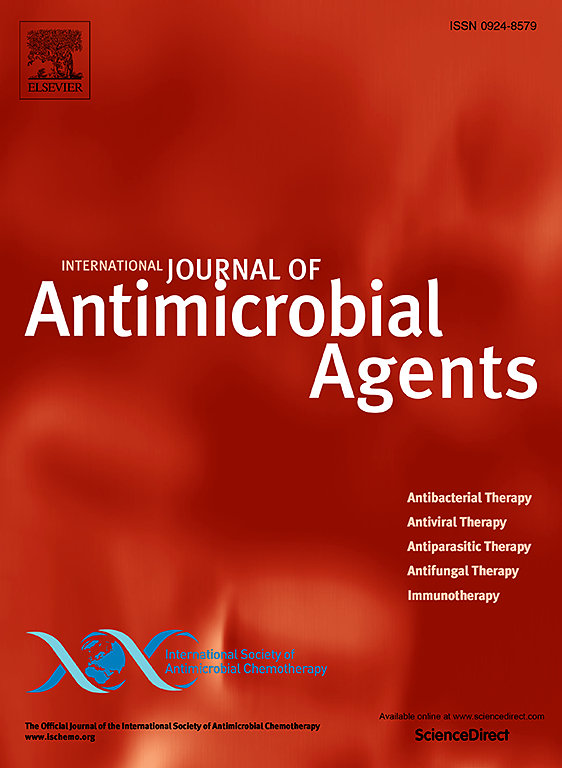Association of antibiotics with Stevens–Johnson syndrome and toxic epidermal necrolysis: A real-world pharmacovigilance study
IF 4.6
2区 医学
Q1 INFECTIOUS DISEASES
International Journal of Antimicrobial Agents
Pub Date : 2025-04-25
DOI:10.1016/j.ijantimicag.2025.107524
引用次数: 0
Abstract
Background
Recent reports suggest antibiotics may cause severe allergic reactions, such as Stevens–Johnson syndrome (SJS) and toxic epidermal necrolysis (TEN), exacerbating concerns about antibiotic safety.
Objective
Given the limited real-world evidence, this study aims to analyse the FDA Adverse Event Reporting System to investigate the association between various antibiotics and SJS/TEN risk.
Methods
Reports from infected patients (Q1 2014–Q4 2023) were extracted from the FDA Adverse Event Reporting System. Disproportionality analysis using information component identified risk signals of antibiotics associated with SJS/TEN. Subgroup analyses investigated the impact of age and gender on antibiotic-associated SJS/TEN. Also, a time of onset analysis was performed.
Results
Among 78 593 infected patients, 1221 cases of SJS/TEN were identified from 30 369 antibiotic administrations. The median age of patients with SJS was 63 y, and with TEN was 60 y. Eleven positive signal drugs were detected through disproportionality analysis. Amoxicillin, piperacillin, ceftriaxone, cefuroxime, cefotaxime, azithromycin, sulfamethoxazole, trimethoprim, vancomycin, doxycycline, and gentamicin exhibited significant risk associations with SJS/TEN. Sulfamethoxazole had the highest risk. Patients with pneumonia, urinary tract infections, and sepsis had higher risks than those with respiratory tract infections. Male patients using specific antibiotics may have a higher risk than females, with no significant age difference.
Conclusions
Antibiotics including penicillins, cephalosporins, azithromycin, sulfamethoxazole, trimethoprim, vancomycin, doxycycline, and gentamicin are associated with an increased risk of SJS/TEN, with sulfamethoxazole presenting the highest risk. Patients with pneumonia, urinary tract infections, and sepsis are particularly vulnerable. These findings highlight the need for personalized antibiotic regimens based on infection site and patient gender.

抗生素与Stevens-Johnson综合征和中毒性表皮坏死松解的关系:一项真实世界的药物警戒研究
最近的报道表明抗生素可能引起严重的过敏反应,如史蒂文斯-约翰逊综合征(SJS)和中毒性表皮坏死松解(TEN),这加剧了人们对抗生素安全性的担忧。鉴于有限的真实证据,本研究旨在分析FDA不良事件报告系统,以调查各种抗生素与SJS/TEN风险之间的关系。方法从FDA不良事件报告系统中提取感染患者(2014年第一季度- 2023年第四季度)的报告。使用信息成分进行歧化分析,识别出与SJS/TEN相关的抗生素风险信号。亚组分析调查了年龄和性别对抗生素相关SJS/TEN的影响。此外,还进行了发病时间分析。结果78593例感染患者中,30369例抗生素用药中,共检出1221例SJS/TEN。SJS患者的中位年龄为63岁,TEN患者的中位年龄为60岁。通过歧化分析共检出11种阳性信号药物。阿莫西林、哌拉西林、头孢曲松、头孢呋辛、头孢噻肟、阿奇霉素、磺胺甲恶唑、甲氧苄啶、万古霉素、多西环素和庆大霉素与SJS/TEN有显著的风险关联。磺胺甲恶唑的风险最高。肺炎、尿路感染和败血症患者的风险高于呼吸道感染患者。使用特定抗生素的男性患者可能比女性患者有更高的风险,没有明显的年龄差异。结论抗生素包括青霉素类、头孢菌素类、阿奇霉素类、磺胺甲恶唑类、甲氧苄啶类、万古霉素类、多西环素类和庆大霉素类与SJS/TEN风险增加相关,其中磺胺甲恶唑风险最高。肺炎、尿路感染和败血症患者尤其脆弱。这些发现强调了根据感染部位和患者性别制定个性化抗生素方案的必要性。
本文章由计算机程序翻译,如有差异,请以英文原文为准。
求助全文
约1分钟内获得全文
求助全文
来源期刊
CiteScore
21.60
自引率
0.90%
发文量
176
审稿时长
36 days
期刊介绍:
The International Journal of Antimicrobial Agents is a peer-reviewed publication offering comprehensive and current reference information on the physical, pharmacological, in vitro, and clinical properties of individual antimicrobial agents, covering antiviral, antiparasitic, antibacterial, and antifungal agents. The journal not only communicates new trends and developments through authoritative review articles but also addresses the critical issue of antimicrobial resistance, both in hospital and community settings. Published content includes solicited reviews by leading experts and high-quality original research papers in the specified fields.

 求助内容:
求助内容: 应助结果提醒方式:
应助结果提醒方式:


